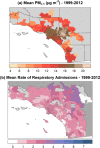Wildfire smoke impacts respiratory health more than fine particles from other sources: observational evidence from Southern California
- PMID: 33674571
- PMCID: PMC7935892
- DOI: 10.1038/s41467-021-21708-0
Wildfire smoke impacts respiratory health more than fine particles from other sources: observational evidence from Southern California
Abstract
Wildfires are becoming more frequent and destructive in a changing climate. Fine particulate matter, PM2.5, in wildfire smoke adversely impacts human health. Recent toxicological studies suggest that wildfire particulate matter may be more toxic than equal doses of ambient PM2.5. Air quality regulations however assume that the toxicity of PM2.5 does not vary across different sources of emission. Assessing whether PM2.5 from wildfires is more or less harmful than PM2.5 from other sources is a pressing public health concern. Here, we isolate the wildfire-specific PM2.5 using a series of statistical approaches and exposure definitions. We found increases in respiratory hospitalizations ranging from 1.3 to up to 10% with a 10 μg m-3 increase in wildfire-specific PM2.5, compared to 0.67 to 1.3% associated with non-wildfire PM2.5. Our conclusions point to the need for air quality policies to consider the variability in PM2.5 impacts on human health according to the sources of emission.
Conflict of interest statement
The authors declare no competing interests.
Figures




References
-
- Reid JS, Koppmann R, Eck TF, Eleuterio DP. A review of biomass burning emissions Part II: intensive physical properties of biomass burning particles. Atmos. Chem. Phys. 2005;5:799–825. doi: 10.5194/acp-5-799-2005. - DOI
Publication types
MeSH terms
Substances
Grants and funding
LinkOut - more resources
Full Text Sources
Other Literature Sources
Medical

